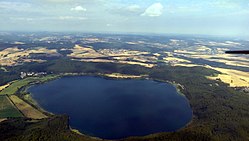



The Volcanic Eifel or Vulkan Eifel (German : Vulkaneifel) consists of three areas of volcanic activity, known as the West Eifel, High Eifel, and East Eifel volcanic fields. Volcanic Eifel is a region in the Eifel Mountains in Germany that is defined to a large extent by its volcanic geological history. Characteristic of the volcanic fields are their typical explosion crater lakes or maars, and numerous other signs of volcanic activity such as volcanic tuffs, lava streams and volcanic craters, for example the Laacher See. The Volcanic Eifel is still volcanically active today. One sign of this activity is the escaping gases in the Laacher See.

